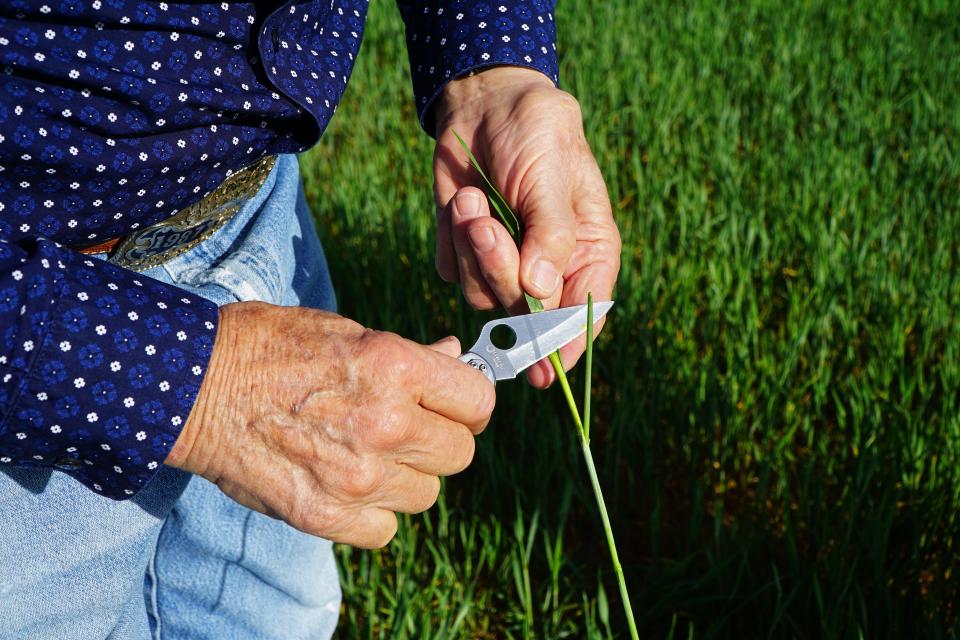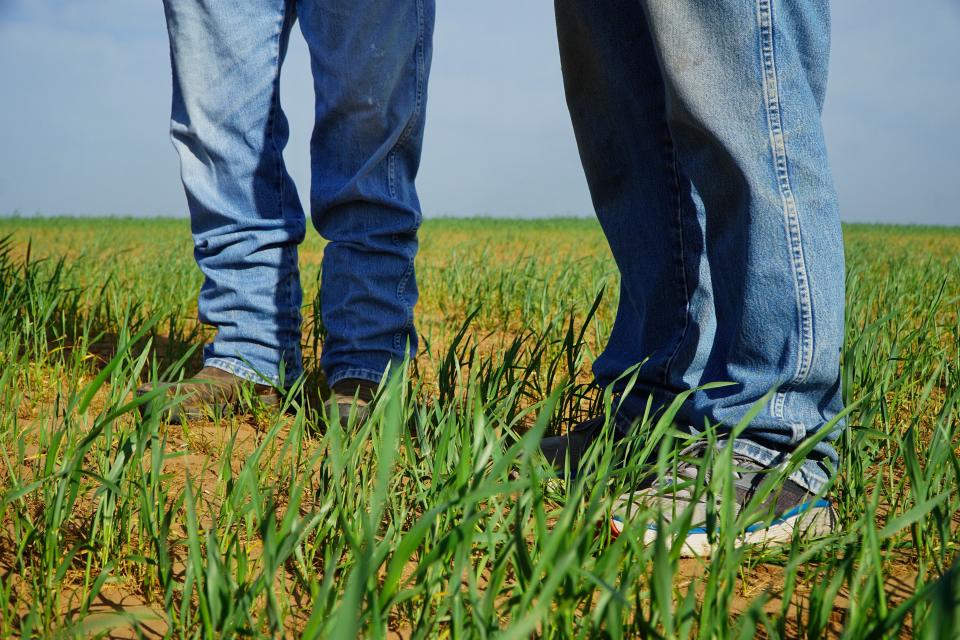'I think we’re to the Dust Bowl.' Oklahoma farmers say wheat crop is worst in decades
BURLINGTON — Looks can be deceiving. Rolling wheat fields may appear green and lively to passing drivers, but the farmers who planted the fields see a different story playing out as their crops die off and blow away.
“We had less than half of a crop last year, and we’re probably going to have half of that this year. It’s terrible,” said 75-year-old Burlington farmer Keith Kisling. “We’re in the most severe drought I’ve ever seen.”
Farmers and agricultural businesses are bracing for the impact of a winter wheat harvest devastated by prolonged drought across much of the United States, including north-central and western Oklahoma. More than half of the Sooner State’s wheat crop is in poor condition, and producers warn that consumers and local economies likely will face financial impacts.

More: Rural Oklahoma's future uncertain in spite of traditional strength in state Legislature.
High winds, low rainfall create dire straits
Severe drought conditions have plagued the state’s two most recent crops of winter wheat, one of Oklahoma’s top commodities. Producers blame the La Nina weather pattern, which occurs when oceanic winds push drier air into the southern portion of the United States.
The United States Department of Agriculture reported April 18 that 53% of the state’s crop was rated in poor or very poor condition. A combination of extreme drought and high winds already have damaged portions of Kisling’s wheat crop near Burlington, a town of about 130 residents in Alfalfa County. The region is in exceptional drought, which is the most severe form, the U.S. Drought Monitor reported April 20.

“So much wind with the dry weather — that’s what the killer is,” Kisling said. “Any moisture we got in the plants, it’s just sucking it right out.”
On April 18, he and his son, Chad, walked through a field they farm west of town. At this time during an average year, wheat would brush against their legs. This year, it touches their ankles. Winds had blown wheat seeds out of part of the field, leaving it barren and brown. Nearby stood yellow patches of dead wheat.
Remaining rooted: Collaboration sown in history impacts the future of Oklahoma agriculture
Chad Kisling said he couldn’t remember the last time a notable rain fell in the region.
“Usually, April showers bring May flowers,” he said. “That’s not true anymore.”
Parts of the region received between two and three inches of rainfall in late April, though farmers don't expect it to have much of an impact on this year's crop yields.
Consumer impact may be less severe than believed

Although much of the state’s wheat crop is in poor shape, families and consumers may not see the cost of bread, flour and other wheat-based goods rise as drastically as they might think, said Dean Scarbrough, dean of the agriculture department at Northwestern Oklahoma State University in Alva.
Despite the war in Ukraine, which has impacted that country’s wheat supplies, Russian wheat production has increased in the past year and continues to reach the world market. The war’s effect on wheat prices may be misunderstood, Scarbrough said.
Other areas of the United States that aren’t as heavily affected by drought will continue to produce wheat, too, Scarbrough said. He doesn’t expect wheat prices to skyrocket as they have during past droughts, such as in 2011.
“It appears that the global markets are going to make up some of that difference,” Scarbrough said. “But local farmers and ranchers are still going to be hurt.”
Growers, but not farmers? Okla. agriculture industry, marijuana producers at odds over SQ 820

Financial losses could harm farming operations
As the nation grapples with high interest rates, farmers who borrow money to sustain their operations will have to pay that money back without having a profitable crop, said Steve Sneary, an NWOSU instructor who manages the university’s farm. The combination could leave family farming operations saddled with significant debt.
“It’ll relegate lots of pressure on young farmers and ranchers that are trying to enter the business,” Sneary said. “They’re counting on a crop to make their land payments and things of that nature, and that’s not going to be there.”
Jacob Webster, a 23-year-old farmer near Deer Creek in Grant County, spent a recent Sunday evening surveying his wheat fields in north-central Oklahoma. His leather cowboy boots were taller than much of the wheat, some of which is yellowing. He’s never seen a worse crop, he said.
“The good thing is today, we’ve got insurance, but the insurance doesn’t pay as well as a wheat crop could make,” Webster said. “With last year not being a very good wheat crop and this year probably not going to be the best, I would expect some people will probably have to fold up. It’s going to be tough.
“I think we’re to the Dust Bowl, about the same or worse.”
More foraging fun: Why this Oklahoma group is going wild for morel mushrooms

Custom cutters, communities stand to lose, too
Wheat harvesting pumps revenue into cities and towns as farmers purchase fuel and parts for equipment, food for workers and storage at grain elevators. Without a sizable harvest, small towns and businesses could face downturns in revenue and other economic activity.
Kris Mapel, a longtime custom harvester in Blackwell in Kay County, said the poor wheat crop will reduce the demand for harvesting crews that travel across the region.
“It’s a trickle-down effect,” Mapel said. “We pour a lot of money into the towns we go to: lodging, meals, fuel, parts, and when we quit showing up … it stretches out a lot further than the farmer.”
Several custom harvesters have ceased operations in the last few years, Mapel said. Harvesters have faced high travel, operational and equipment costs, and limited federal assistance is available to them during droughts and other downturns in agriculture.
Mapel said this year will be challenging for almost everyone involved in agriculture, especially in Oklahoma.

“I haven’t seen this in Oklahoma this widespread, maybe ever,” Mapel said. “It’s a wait-and-see game. Acres have to be cut, but nobody wins.”
Back in Burlington, Kisling said he and other farmers are hopeful that the shift to the El Nino weather pattern — which typically brings more moisture to the American South — will begin soon enough that summer crops and next year’s crops can thrive.
“There’s always hope. The farmer, he’s always looking at the next year’s crop,” Kisling said. “This one’s too late.”
This article originally appeared on Oklahoman: Oklahoma farmers say drought, high winds have decimated wheat crop
